The Valley of Saints’ Strife
Kashmiriness is on high alert in the diaspora
by Manahil Zafar
While Kashmir Valley is subjected to a harsh clampdown imposed by the Indian government, Kashmiri expatriates juggle their emotional reactions to the violence in their motherland, their complex sense of identity and home, and their efforts to advocate for the voiceless people of Kashmir.
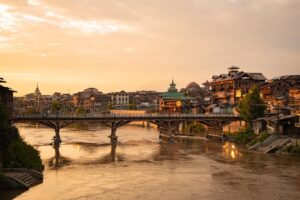
Srinagar, Kashmir. Photo courtesy of Aamir Wani.
For the Kashmiri expatriate community, the looming threat of war back in their homeland feels like a black cloud someone paid to tail them. Although religion, culture, and nationality systemically divide the nearly 7 million people of Kashmir, diasporic Kashmiris of all persuasions have rallied together to bring this issue to the world’s attention. They have used the internet and social media platforms—India still restricts access to full-speed internet in the Kashmir Valley—to reach a larger audience and create awareness for the strife.
The conflict over Kashmir erupted in 1947. Since then, India and Pakistan have gone to war three times over the large Himalayan territory (in 1947, 1965, and 1999). Pakistan, India, and China have dissected the land in such a way that each nation claims a fraction of the land as their own. This battle over borders has given rise to a large-scale identity crisis; should Kashmiri émigrés identify as Indian, Pakistani, Muslim, Hindu, or just Kashmiri? If they fall into more than one of these identity buckets, do they choose one over the other? Should they have to?
The Kashmir Valley lies within the now Indian union territory of Jammu and Kashmir, surrounded by quiet mountains that look like a Bob Ross original painting. The still water of Dal Lake shines as if through a portal to the sky above, a continuum of blueness connecting at the horizon. The mountainous region is one of the most densely militarized zones in the world and is disputed between India and Pakistan, two nuclear-armed sister nations. And while the Indian paramilitary forces unleash violence in the Indian-administered region of Kashmir, its 8 million resilient locals stand unwavering, like the snow-capped mountains, refusing to give in to the pellet gun rains, concertina wire scratches, and tear gas suffocation.
The Valley, also known as the Valley of Saints, is once again caught between India’s and Pakistan’s never-ending game of tug-of-war, with no designated referee to arbitrate. On Aug. 5, 2019, India revoked Article 370 of its constitution, a clause that granted Kashmir special semi-autonomous status, citing plans to revitalize Kashmir’s economy and encourage one-ness with the rest of India. The Indian government took swift preventative measures to quell dissent, subjecting Jammu and Kashmir, the only Muslim-majority Indian state, to a year-long partial communications blackout, arrests and detention of local government officials without trial, and an alarming rise in military presence, injuries, and death in the region. These egregious human rights violations, including assassinations of rebel leaders, unwarranted arrests of civilians and journalists, and the kidnap, torture, and rape of civilians, make it difficult for Kashmiris in the Valley to contact each other and their loved ones overseas. In response, community members in the diaspora have risen up against the injustice. But when they stop and think about Kashmir, they grapple with this painful question: what is home?
![]()
When Daisy Khan was 16 years old, she left her home in Kashmir Valley for the United States. She exchanged her open fields and mountain adventures for skyscrapers and the urban jungle of New York City. After the move in 1974, Khan found her voice as an emigree, doing what she did best: fighting for religious equality, peace, and human rights. Leaving behind a lucrative architecture career in 2005, she founded the Women’s Islamic Initiative for Spirituality and Equality and rose to prominence after 9/11 as a champion for the Muslim community.
The men who have pursued Kashmir ignored her wishes for more than 72 years. Khan’s Kashmir has no voice.
Khan’s Kashmir is like a Bollywood trope. In her mind, the story goes something like this: Kashmir is a beautiful sought-after young woman who wants to marry Pakistan. Her father ignores her desire and arranges for her to marry India, asking India to save her from Pakistan. The marriage is tumultuous. Pakistan, aware of his beloved Kashmir’s distress, decides to fight to get her back.
India and Pakistan go to war twice over Kashmir’s heart, never considering that the choice really should belong to Kashmir. “She just wants her peace,” Khan said, continuing her tale. “But for them, it’s about winning her. They just gotta have her.”
The men who have pursued Kashmir ignored her wishes for more than 72 years. Khan’s Kashmir has no voice.
Even though Khan now lives two oceans away from where she grew up and has lived most of her adult life overseas, her motherland has never left her. It is the deepest part of her identity because her “reality has been shaped by 70 years of siege.” When Kashmir is under attack, her “Kashmiriness is on high alert. Everything that was suppressed and kept back comes to the fore.”
Hearing stories from her loved ones under military watch back home is difficult for Khan, not only because India imposed a ban on landline and mobile phones, as well as completely shut down internet access for more than a year now, but also because of the distance between her and the land she grew up in. The actions she can take are limited. She laments how common the sight of death and destruction has become for her people. “We’re just not a violent people. It’s not in our DNA.”
![]()
For Farah Kathwari, a second-generation Kashmiri American who lives in upstate New York, now is the time for Kashmiris everywhere to combat the Indian government’s fascist endeavors. But before everyone gathers in solidarity, she also believes it is important to understand who ethnic Kashmiris are.
“The people there are suffering and they don’t have a voice. So, we don’t have that luxury to be helpless or to feel paralyzed.”
“The use of the word Kashmir is basically a misnomer,” she said, as she named the five distinct regions of the territory: Gilgit, Baltistan, Jammu, Kashmir, and Ladakh. “And the main part that’s actually where the Kashmiri language is spoken and that’s ethnic Kashmiri is the Valley and along the border of that part.” Gilgit and Baltistan are the two areas that comprise Pakistan-administered Kashmir. The Jammu and Kashmir Reorganization Act, enacted on Oct. 31, 2019, split the Indian state of Jammu and Kashmir into two union territories. The union territory of Jammu and Kashmir (within which the Kashmir Valley is the main region under dispute) comprises the two distinct regions of Jammu and Kashmir. And Ladakh is the second union territory, which, combined with Jammu and Kashmir, comprises Indian-administered Kashmir.
Kathwari spends her time fighting for her people via her involvement with organizations that mirror her personal mission statement. She is an active board member of the Westchester County Human Rights Commission, the New York Committee of Human Rights Watch, and Refugees International. “I feel like my heart breaks every time I read another story,” she said. “The people there are suffering and they don’t have a voice. So, we don’t have that luxury to be helpless or to feel paralyzed.”
Kathwari’s pain permeated her words. Having visited Kashmir almost every summer during her childhood, she remembers her home fondly. Things changed after the militancy broke out in 1990 and Kathwari’s routine trips became intermittent visits because of safety concerns. She did manage to visit four more times. But after 2007, the Indian government has denied her travel visas on several occasions, likely, she thinks, as a result of her outspoken advocacy in the United States. Most recently, Kathwari was meant to travel to Kashmir with her family for a wedding in July 2019, a month before the clampdown, but when her children were granted visas and she was not, the plan was scrapped.
Growing up, English was the primary language in her household. Kathwari’s parents spoke Kashmiri at home, which meant she understood the language but couldn’t speak it herself. To her surprise, when her daughter was born, Kathwari caught herself subconsciously using Kashmiri words as terms of endearment and reprimand. With every kya chuuh karaan (what are you doing?), mah-kar (don’t do that), tsrat peych (used to describe children, and sometimes adults, who are hyperactive), her Kashmiri identity began to resurface like it was a buried treasure chest she had finally unlocked.
With the consistent crackdown on internal and external communications in the Valley, uncertainty and dread has become the new normal. “It’s been 100 days. There have been extended periods of curfew in the past. But this has never happened where people’s landlines and cell phones and internet was completely cut off,” Kathwari commented during an interview in Nov. 2019. “So, they can’t even call each other. They can’t call for a doctor. They can’t call the hospital. You can’t call family members.”
Months later, in a follow-up conversation with Kathwari at the end of June 2020, she said, “It has now been 10 months and some phone lines have been restored but not all.” She expressed her increasing concern for the people of Kashmir, who now have to deal with the novel coronavirus pandemic and even more death. “It confounds the problems,” she added.
Kathwari believes Kashmiris in the diaspora and allies of the community need to take action. She recommends calling Congressional representatives and never wavering from the core message: “We want an end to the communications blockade. We want a restoration of 370 and 35A [an article of the Indian Constitution, which falls under Article 370, that granted permanent residents of Jammu and Kashmir special rights and privileges], and we want demilitarization. There are like 700,000 troops in the region. The place needs to be demilitarized,” Kathwari listed. “And then we want a resolution to the issue with Kashmiris at the table. Kashmiris have to be at the center of that.”
![]()
The incumbent political party in India, the Bharatiya Janata Party, has campaigned, promoted and adopted Hindutva ideology, or Hindu fascism, once again after its 2019 re-election. Prime Minister Narendra Modi promised to make India great again and pushed a Hindu nationalist vision that belied the country’s democratic and pluralist foundations. With new laws to dehumanize and target Muslims and other non-Hindu minorities in India and its territories, the Indian government has taken political action that risks the security of a large population of people who call India home. Modi’s Citizenship Amendment Act is to his Hindu nationalist supporters what President Donald Trump’s Muslim ban is to his xenophobic American base.
College campuses across the nation have organized protests to combat Islamophobic trends in democratic countries and vocalize support for the Muslim community. An email from the South Asia Society at New York University to its 252 club members encouraged the recipients to stand in solidarity against Hindutva by reading aloud the preamble of the Indian Constitution in unison on February 13, 2020. The preamble reads:
“WE, THE PEOPLE OF INDIA, having solemnly resolved to constitute India into a SOVEREIGN SOCIALIST SECULAR DEMOCRATIC REPUBLIC and to secure to all its citizens:
JUSTICE, social, economic and political;
LIBERTY of thought, expression, belief, faith and worship;
EQUALITY of status and of opportunity;
and to promote among them all
FRATERNITY assuring the dignity of the individual and the unity and integrity of the Nation;
IN OUR CONSTITUENT ASSEMBLY this 26th day of November, 1949, do HEREBY ADOPT, ENACT AND GIVE TO OURSELVES THIS CONSTITUTION.”
And the protesters did. Red, pink, and white signs lay resting along the bottom of the steps, still and loud. What once was an orchestra of people became a solo performance, with the resounding hum of resistance in every chant. “Hum kya chahte? Azadi!” they shouted. “What do we want? Freedom!”
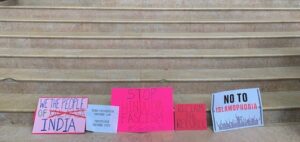
Hand-made signs at the bottom of the Kimmel Center staircase. Photo by author.
![]()
Hafsa Kanjwal was born in 1986 in Srinagar, the summer capital city of Jammu and Kashmir, at a time when the region was politically volatile. Her parents, both doctors, decided it was best to move to the United States in 1993, four years after an armed rebellion broke out in response to earlier rounds of violence and injustice in Kashmir. Kanjwal, an assistant professor of South Asian history at Lafayette College in Easton, Pennsylvania, openly speaks about her lived experiences in the hope it will bring awareness to her community’s cyclical suffering.
Thoughts of being away from home plague Kanjwal’s mind. “I always do feel that my chances of going back there will get more and more difficult, especially if the government becomes authoritarian,” she said. “Sometimes, really every time I’m there, I potentially feel like ‘okay, this could be the last time that you’re allowed back here.’” Kanjwal felt this way when she last travelled to Kashmir to visit her sick grandmother in July 2019.
So, Kashmir is in everything Kanjwal does. She teaches Kashmiri history, leads nation-wide dialogues and teach-ins on the Kashmir conflict, and writes about her Kashmiri identity. She is Kashmir in America.
And she brings America to Kashmir. In 2007, with the help of other Kashmiri American undergraduate students at Georgetown University, Kanjwal co-founded a nonprofit organization called KashmirCorps. For three summers, the organization sponsored trips to Kashmir for non-Kashmiris to engage in local public service projects. However, the project was unsustainable because of increasing security concerns in the region. Volunteers could not immerse themselves in the community and had to adhere to curfew by staying indoors, away from gunshots, riots, and general unrest.
“If you see this kind of rhetoric that completely denies that human rights violations are happening, it’s Islamophobic.”
Kanjwal visited Kashmir almost every summer after 2006, further strengthening her love and connection with the place she was born. And now, with the clampdown on the Valley, moments of overwhelming Kashmiriness are routine for her. “It’s very much on the front of my identity and my sense of self. And of course, you know I tried, to a certain extent, to speak Kashmiri, especially more recently with my parents and with my friends and things just to keep that alive.”
Kanjwal, who identifies as Muslim, is aware of the disparate narratives among some members of the Kashmiri Pandit, or Hindu, population. The political context of an armed rebellion in the Kashmir Valley resulted in a vast majority of Kashmiri Pandits to leave their homes in the Valley, and there has been an irreparable rift between Muslim and Hindu Kashmiris ever since. But Kanjwal believes an eye for an eye is not the solution here, just like it is not the solution in most international conflicts.
“The Indian state has used the tragedy of the Kashmiri Pandits to demonize Kashmiri Muslims and many of the Pandits, who have lived outside of Kashmir for all these years, have internalized a lot of that rhetoric,” Kanjwal said.
Kanjwal believes there should be no doubts about the death and discomfort in the Valley. She points to documentation in fact-finding missions, international news outlets, and local reports for support.
“If you see this kind of rhetoric that completely denies that human rights violations are happening, it’s Islamophobic,” Kanjwal said. “It’s this kind of brainwashing that has occurred where you’re completely unable to see the humanity of this group of people and you think that what is happening to them is deserving of them because the only way that you can see them, or frame them, is as terrorists.”
Kanjwal has a political revolution in mind that would be the ideal next step for the people of Kashmir but she really just wants her people to live free, dignified lives, without fear of state-sponsored cruelty. At the time of our interview in Nov. 2019, Kanjwal had not heard from her friends living in Kashmir in the months after the events of Aug. 5, 2019.
In a follow-up conversation in June 2020, Kanjwal emphasized the increasing severity of the crisis with the novel coronavirus pandemic in the picture. “Kashmiris are now facing an existential threat,” she explained. “Using the guise of COVID-19, the Indian state has passed a series of laws that will incentivize a setter-colonial project in Kashmir, which will change the demography of the region from a Muslim-majority to a Hindu-majority. This is incredibly troubling, especially given that this process entails ethnic cleansing and genocide. So, for Kashmiris the Indian occupation remains the greater threat, even in the time of a pandemic.”
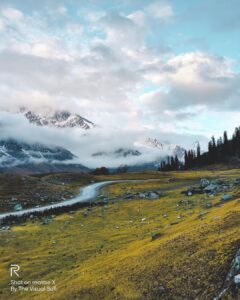
Kashmir Valley. Photo courtesy of Mohsin Lone.
![]()
Unlike Kanjwal, Nitasha Kaul was not born in Kashmir but longed for the day she would be able to set foot on Kashmiri soil for the first time. Born to Kashmiri parents, Kaul grew up in Delhi, India and moved to England at the age of 21 in 1997. Not knowing much about the devastating Kashmiri Hindu exodus in 1990 as a child, she was always unsure of how to respond to her classmates’ pointed questions about her identity. “Recite Kashmiri,” they’d say. “How do you recite a language?” she wondered. Kaul has explored the sentiment of being in a place, but not of that place for as long as she can remember. “I was in Delhi but Delhi wasn’t where I was supposed to be. Well, then where was I supposed to be? I was supposed to be in Kashmir but then why wasn’t I in Kashmir? And nobody had a good answer to it.”
Kaul is an associate professor of politics and international relations at University of Westminster in London, and prefers to talk more about her academic work on South Asia rather than divulge details about herself. But she could not stay silent after the 2010 uprisings in Kashmir. On Oct. 22, 2019, Kaul provided her expert testimony at a hearing entitled “Human Rights in South Asia: Views from the State Department and the Region” before the United States House Committee on Foreign Affairs. During her live testimony before the House of Representatives, Kaul spoke with the determination and ease of a natural leader, reminding everyone in the chamber why they should care about Kashmir. “The question here is really not so much about Article 370. The fundamental question here is about the consent of the people.”
Kaul’s frustration at the undemocratic actions of the Indian government leapt off the screen. “If something is being carried out for people’s welfare, for their development, then why does it need tens of thousands of troops being brought in? Why does it have to happen overnight without absolutely any consultation of the people, with placing even the pro-India politicians in prison, and then depriving the population of the right to say anything? If it is for their good, then why isn’t any one of them allowed to say anything about it?” Kaul emphasized.
She continued on, warning the committee of what could come next and used historical analogies to provide support for her argument. “Please also remember that the New York Times in 1922 had profiled Hitler saying that Mr. Hitler’s antisemitism is neither as violent nor as genuine as it sounds,” Kaul said. “So, things take time to unfold and the proto-fascist trajectory that, sadly, the secular democracy of India is on is very worrying for us all.”
During our interview in London, a personal question evoked from Kaul the never-assembled pieces of a complex identity puzzle. Sporadically, she traveled back and forth from the 1990s to the 1970s to present day and then back again in her mind, as if she couldn’t quite make the pieces fit. Kaul said she is a citizen of “nowhere”: a word that can be split into ‘now’ and ‘here’. Kaul’s home is a feeling. It’s the feeling of belonging. It’s the feeling of being surrounded by green fields and translucent water. Kaul feels home in Srinagar, in “the mountains that ring it, the reflections, the almost inexplicable way in which you fit into that landscape.” Home can also be felt in London, where she looks up at the grey sky and imagines the clouds are mountains. Kaul’s home, wherever it is, definitely has mountains.
“No matter where in the world I am, if I am going through something that is particularly traumatic, I will say, ‘I just want to go home’, without quite knowing where that home is,” Kaul explained.
Over the years, Kaul has experienced strained relationships and severed ties with many of her close relatives because of differing views on the Kashmir crisis. It’s difficult for her to keep the professional from affecting the personal when it comes to the militarized conflict. So, Kaul channeled her innermost feelings into Keya Raina, a fictional character she penned in her novel Residue. She found comfort in attributing her turmoil to someone who does not exist and used a creative outlet to say things she wasn’t used to saying about her Kashmiri identity. And in time, after the 2010 uprisings, Kaul realized silence was not an option. But she ran into trouble when others questioned her Kashmiri identity and authenticity, as a Kashmiri Pandit who was not born and brought up in Kashmir.
“If you make it about authenticity, then you have people saying, ‘Well, look, me or mine suffered in this way’, and then you have different communalized accounts of that suffering,” Kaul said. “And I want to say, why have a this-versus-that when it comes to suffering, especially in the way in which Kashmiri Pandits’ and Kashmiri Muslims’ suffering has been made sense of?”
Kaul finds sentimental value in items from Kashmir. She holds on to precious items from home like people hold on to old photographs. Carefully, she stores antique wooden carvings from Kashmir wrapped delicately, tucked away in boxes where they stay safe. She still makes sure to find out when her second birthday, her Kashmiri birthday, is every year. She celebrates both.
Kaul prides herself on her reliable episodic memory. She can to this day see herself standing near the waters of Dal Lake, wandering down the boulevard, looking at her reflection in fountains. These images run through her mind like scenes from a film, reel after spectacular reel.After an hour and a half of sitting outside some cafe near the University of Westminster, sipping hot coffees in the quiet rain, I asked Kaul for any lingering thoughts she might have after our conversation. If there was anything she wanted to say that she had not said during our interview, that was the time. Kaul paused for a moment, chuckled, and said, “Hum kya chahte? Azadi!”
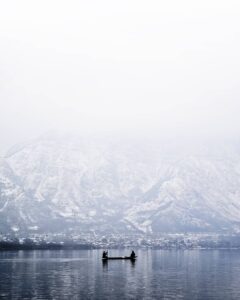
Dal Lake, Srinagar, Kashmir. Photo courtesy of Aamir Wani.
![]()
Eighty-four days into the lockdown on Kashmir, or Oct. 27, 2019, Stand With Kashmir, a volunteer-run advocacy organization, held a vigil in Times Square to mark 72 years of Indian military presence in Kashmir, 72 years of persecution and repression, 72 years of Kashmiri resilience. Red lights shone down from the large digital displays and made the red Stand With Kashmir shirts of the large crowd resemble a deeper, bloodier shade. The Square was more packed than usual and the red sea garnered attention from passersby, who would stop, stick around for a minute or two, and then either decide they needed to keep moving, or ask ‘what is this for?’ and stay a while longer.
Performance artist, activist, and Muslim faith leader Afraz Khan was called up to the makeshift stage to read an original piece. He spoke with rage, grace, and a little bit of faith.
“Kashmiris know nothing but resistance.
Jummah prayers turn into street protests, souls fighting evil, risking death, and fearing nothing but God
Apple orchards turn into rotten crops, farmers fighting corporate greed, risking livelihood and never betraying the martyrs
Villages turn into watch units, leaders fighting abduction, risking their arrest and serving no one but their people
I thank God for the people of Kashmir
A source of hope amidst despair
A ray of light emanating true resistance felt all the way in Times Square
I bear witness to Kashmir”
Another honored speaker at the vigil was Dr. Tanveer Mir. The chairwoman and program director of the Department of Medicine at Brooklyn’s Wyckoff Heights Medical Center walked up to the stage, faced the crowd with a dying microphone in her hand, and spoke with quiet determination. “Today is the day of resistance. A day of resistance for all Kashmiris.” Mir’s speech highlighted the need to put an end to the decades-long strife of the Kashmiri people and the never-ending military threat to their loved ones. Her words elicited cheers from the crowd. Mir expressed similar passion during our conversation in her office at Wyckoff Hospital on the 100th day of the lockdown.
Mir was born and brought up in Srinagar, Kashmir. Like all of her family members before her and all of her family members after her, she attended Presentation Convent Higher Secondary School, a private Irish Convent school located on the edge of the Jhelum River. Growing up in a secular environment, Mir remembers joyful memories with her childhood school friends, emphasizing that it didn’t matter what specific subtype of Kashmiri they identified as. “Religion was never an issue,” she commented. “But I think now there’s a deep divide with what seems to be some kind of deep sense of identity that is based on religious grounds. And I think it’s causing not only a big divide in the country, but a lot of suffering for the 8 million Kashmiris.”
Mir graduated as valedictorian from Government Medical College, Srinagar in 1981. After getting married, she emigrated to Long Island, New York to join her husband, who had settled in the United States a year before she arrived. Mir’s mastery in the medical sciences is apparent: she is an internist, a gerontologist, a palliative physician, and a bioethicist. “I feel that, as physicians, we are humanitarians at heart,” she said.
So, she is no stranger to advocacy. Mir has dedicated her whole life to fighting for others, in both a personal and professional capacity. What started as advocacy for health-care-related issues snowballed into advocacy for all human rights causes. And because her efforts would not be possible without the freedom she’s afforded in the United States, Mir never takes these liberties for granted. “An expression of that freedom, whether it’s Twitter or whatever, is big and that’s really meaningful because, at the end, you’ve got to stand up for your values,” she said, with a smile. “And without that, there’s no purpose in life.”
“Everyone suffers in Kashmir but we all suffer different levels of oppression because of our privilege.”
For Mir, her husband (who is a pulmonologist), and her three adult children, home is not just one place. It’s an intricate combination of all of the places where she has left bits of herself, the places where her family has the comforts they need to live happily, and the places where they are all free to live without restraint. “Home for us is where we are, which is New York,” she said. “But I think home is also what we left behind, which is Kashmir.”
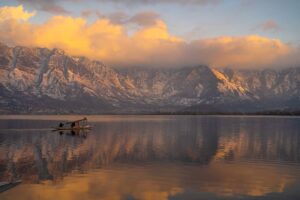
Dal Lake, Srinagar, Kashmir. Photo courtesy of Aamir Wani.
From her home in New York City, Mir can only infer what the future of the Muslim-majority Jammu and Kashmir will look like. She, like many Kashmiris in the diaspora, is skeptical of the Indian government’s welcoming of Jammu and Kashmir and Ladakh as two new federal territories, purportedly for the region’s economic and political prosperity. If Prime Minister Modi’s selling this perfect peaceful picture of Indian involvement in Kashmir, Mir isn’t buying.
“Whether this is an intentional demographic change that the authoritarian Modi government wants to bring about or not, time will tell,” she ventured. “But it’s more than speculation because there’s nothing else to convince any educated person that there’s any benefit from this process to either Kashmiris, India, or Pakistan.”
![]()
Lucrative lawyer, award-winning cyclist, and Kashmiri expatriate Mirza Saaib Bég shifted from India to London in 2018 to pursue his master’s degree in public policy. Bég grew up in the Valley. He attended Iqbal Memorial Institute in Bemina, Srinagar. About a 20 minute walk away is Raahat Manzil, one of Kashmir’s largest orphanages. Going to school with peers from Raahat Manzil first made Bég aware of his privilege. “Everyone suffers in Kashmir but we all suffer different levels of oppression because of our privilege.”
Bég graduated from NALSAR University of Law in Hyderabad, India in 2013. His time in law school with classmates from different regions in India opened his eyes to how atypical his childhood had been. He envied the idyllic lives his classmates lived. “They don’t know what it means to see your parents, or your grandparents, standing at the gate of your house if you are late by 15 minutes, and to see that expression of worry, of concern, on their face just because you are delayed a little bit,” Bég explained. “I grew up in a time when we didn’t have mobile phones. There’s no way to contact me if I get late.”
The first thing he learned in law school was that everyone has a different definition of the law. As someone who comes from a conflict zone, Bég elaborated, “You understand the law is something which is an oppressive tool, which is meant to illegalize you as a person.”
Kashmir Reading Room is a project that is close to Bég’s heart. The project aims to educate the general Indian public on Kashmiri strife, to counter government propaganda on Kashmir, and to generate healthy political discourse. Bég, a founding member of the Reading Room, uses the Reading Room to humanize Kashmiris. For instance, he would address a skeptic and say something like, “Is there freedom of expression in Kashmir? Is there democracy? Are you truly socialist? Are you secular?” He would keep pushing for answers. Then, he’d ask about the Indian Constitution. “What do these terms even mean in this document that you are pledging yourselves to when it does not apply? When it does not uphold these values in Kashmir?”
Bég is creative when it comes to giving back to his communities. He is a cyclist. And with every kilometer he pedals, he fundraises money to provide resources for orphans in Srinagar as well as scholarships for Kashmiri law students.
“I might spend many years here, get the accent, learn these things, but at the core of my being because it means so much, we’re so affected and so touched by, so burned by the conflict that we’ve experienced, it becomes an integral part of you.”
Prior to his move to London about a year ago, Bég worked as a legal advisor for the Indian Ministry of Finance. But when he, alongside a few colleagues, drafted and filed a petition with the Supreme Court of India opposing the revocation of Kashmir’s autonomy, the Indian government sent him a notice that stated he could not criticize the government being an employee of a statutory organization. He decided to resign, knowing that he could afford to sacrifice his job for his freedom of speech, a luxury he recognizes most Kashmiris do not have.
Bég is still not accustomed to the differences between Kashmiri and British cuisine, despite having lived in England for a year. “Now I’m sort of getting to a point where I don’t reach for the salt and pepper when I go to a restaurant,” he laughed freely. And on a larger scale, Bég is still not accustomed to the countless differences between Kashmir and England.
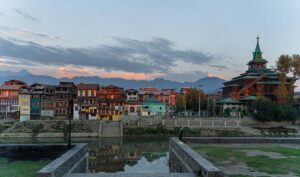
Srinagar, Kashmir. Photo courtesy of Aamir Wani.
When Bég is asked about his home, belonging, and nationality, he analyzes what it really means to be of a place. And his answer never changes. His home is Kashmir. It’s the only place he calls his own. “I might spend many years here, get the accent, learn these things, but at the core of my being because it means so much, we’re so affected and so touched by, so burned by the conflict that we’ve experienced, it becomes an integral part of you.”
For Bég, India and Kashmir have a long and complicated relationship that informs how he and many of his community members identify. “What defines your nationhood is your acceptance of this shared history, shared identity, shared narrative. And we don’t share that narrative, which is why Kashmiris don’t call themselves Indians,” he said. “We call ourselves Kashmiri.”
![]()